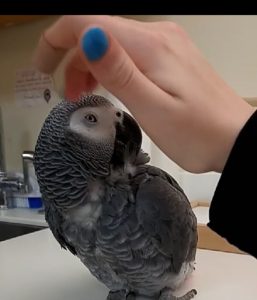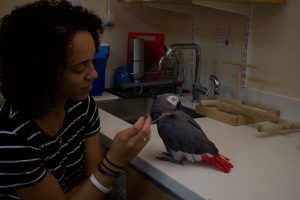
In the wild, parrots often engage in what is termed “allopreening”— one bird will preen the head feathers of another, generally to remove feathers that are either ready to molt or to help crack the keratin sheath that envelops emerging feathers after the molt (we use the term “popping a quill” in the lab). The behavior is usually reciprocal. Most often, birds that allopreen each other are mated pairs, and the preening helps maintain their pair bond.
Some studies on flocks of captive budgerigars suggest that young, unmated parrots may have particular “buddies” that engage in such reciprocal behavior, but such behavior might have more to do with establishing social order (NB: see article by Abassi and Burley, 2012). But what happens in a situation where birds cannot form such bonds? Such can be the case for a single companion parrot and for birds that are (for many good reasons) kept in individual cages and apart from one another when outside the cage. Many birds figure out compensatory behavior patterns — rubbing their heads against cage bars or toys, and scratching vigorously with their feet. But these patterns do not provide much social interaction, something that is the “norm” for a flock animal like a parrot.
As a consequence, many companion birds have also figured out another compensatory pattern — getting their owners to do the job! Parrots often solicit humans by putting their heads down and rubbing against their humans’ fingers; some will even learn to request “Tickle,” “Scritch,” or “Scratch.” Despite being subjects of scientific study, the birds in my lab are no exception, and they have influenced their trainers’ behavior in some striking ways.
 Griffin, for example, likes “spoon tickles” (see picture). When he was a chick, he would sometimes nip a student who tried to preen quills that weren’t quite ready to pop. One of the students in the laboratory figured out that she could use the tip of a spoon instead of her fingers to scratch his head, and thus avoid any unwanted responses from him. The system works particularly well for new students who have never interacted with parrots before, and even for experienced students who are still quite wary of Griffin’s beak. Nowadays, if Griffin is sitting on a laboratory counter and wants preening, he will often pick up a spoon and drop it over the edge to attract a student’s attention. At the very beginning, however, Griffin didn’t quite understand how the system worked. One day, as a chick, he picked up a spoon himself, held in against his head, and waited. When nothing happened, he shrieked and THREW the spoon — he hadn’t realized that he needed a human to make the spoon do the work!
Griffin, for example, likes “spoon tickles” (see picture). When he was a chick, he would sometimes nip a student who tried to preen quills that weren’t quite ready to pop. One of the students in the laboratory figured out that she could use the tip of a spoon instead of her fingers to scratch his head, and thus avoid any unwanted responses from him. The system works particularly well for new students who have never interacted with parrots before, and even for experienced students who are still quite wary of Griffin’s beak. Nowadays, if Griffin is sitting on a laboratory counter and wants preening, he will often pick up a spoon and drop it over the edge to attract a student’s attention. At the very beginning, however, Griffin didn’t quite understand how the system worked. One day, as a chick, he picked up a spoon himself, held in against his head, and waited. When nothing happened, he shrieked and THREW the spoon — he hadn’t realized that he needed a human to make the spoon do the work!
Both Griffin and Athena have also made it very clear that they have preferences for students who have strong, longish fingernails — they choose to spend a lot more time with such students. As a consequence, in order to curry favor with the birds, many of the female students have been investing in special nail kits that strengthen and elongate their nails,! Silver and blue polishes both seem to be a bit hit (see picture above). Maybe because those colors make the nails look more “beak-like”?
Abassi, P., & Burley, N. T. (2012). Nice Guys Finish Last: Same-sex Sexual Behavior and Pairing Success in Male Budgerigars. Behavioral Ecology, 23, 775-782.





